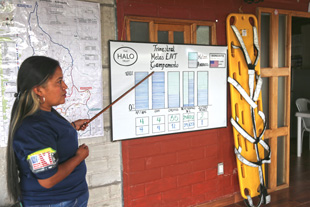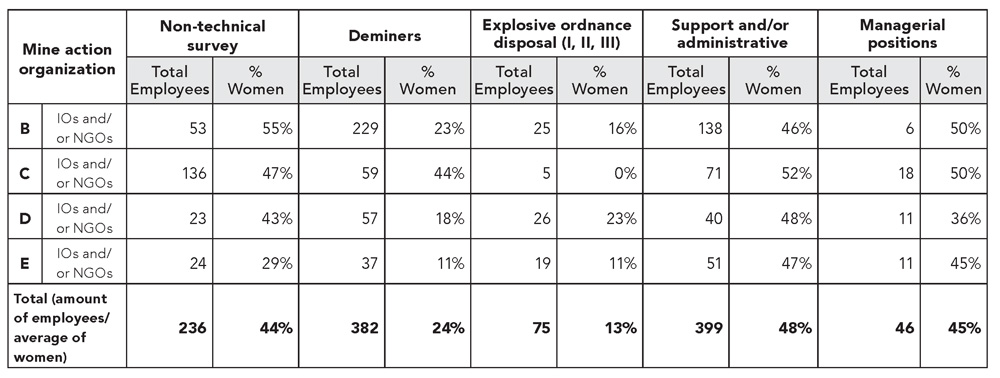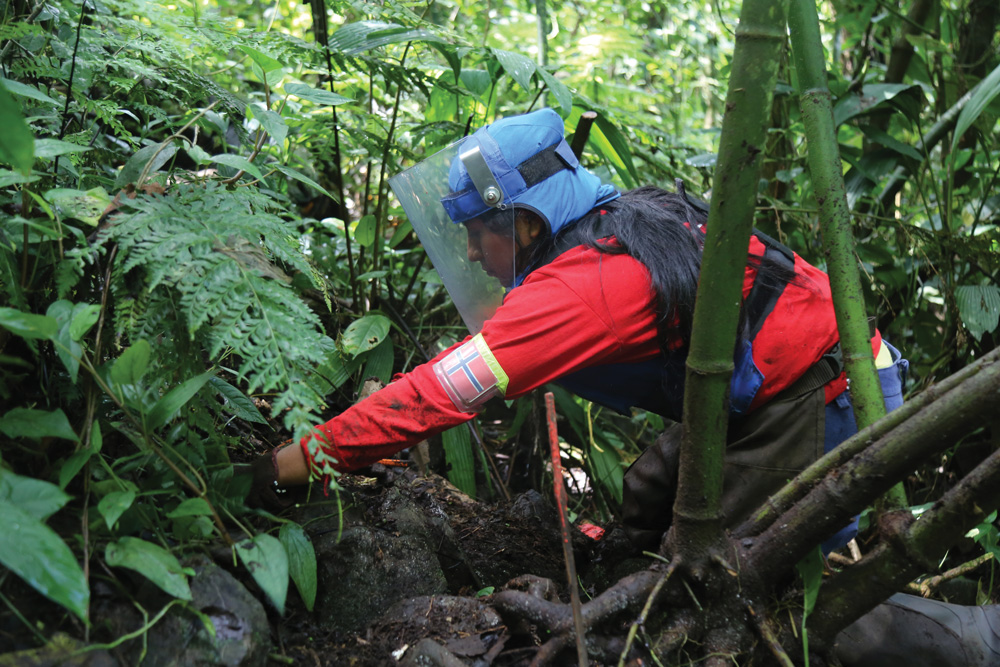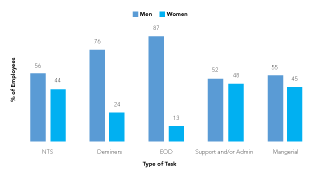Gender and Diversity Mainstreaming in Mine Action: Where are we in Colombia?
By Salomé Valencia Aguirre, MD, Angela De Santis, PhD, Sandra Salas-Quijano, MA[ Fondation Suisse de Déminage ],Liliana Duica-Amaya, PhD [ Consultant ], and Sebastián Tovar Jaramillo [ Fondation Suisse de Déminage ]
CISR JournalThis article is brought to you by the Center for International Stabilization and Recovery (CISR) from issue 27.1 of The Journal of Conventional Weapons Destruction available on the JMU Scholarly Commons and Issuu.com.
Women, girls, boys, and men are affected differently by landmines and explosive remnants of war (ERW) and hold different views on the challenges presented by them. Gender and other diversity factors, such as ethnicity and disability, condition individual views on vulnerability, needs, and coping capacities. This paper aims to identify the progress made by the humanitarian mine action (HMA) sector in Colombia toward gender equity and diversity through various methodological approaches and indicates that gender and diversity gaps persist. The greatest progress has been made in terms of policies and data disaggregation. We understand that public and organizational internal policies can contribute to equality; however, these should be reflected in both recruitment processes and differentiated approaches to mine action operations.
Regarding mine action and gender equity, Security Council Resolution 1325 (2000) on Women, Peace and Security, specifically links gender and mine action as it is “Emphasizing the need for all parties to ensure that mine clearance and mine awareness programs take into account the special needs of women and girls.”1 This progress was preceded in 1948 by the UN Universal Declaration of Human Rights, which formally recognizes the equal status of men and women,2 and in 1978 by the UN Convention on the Elimination of all Forms of Discrimination Against Women.3 To move toward fulfilling the commitments and objectives established in these international agreements, it is necessary to create strategies that acknowledge the differentiated effects of anti-personnel mines according to population groups, including girls and women, as well as the way in which these differences are addressed from the HMA perspective, in order to mitigate their impacts. Gender mainstreaming was defined to include women’s and men’s concerns and experiences; assess the different implications that any planned action has for women and men; ensure that women and men benefit equally; and ensure that gender inequality is not perpetuated.4 In 2006, the “United Nations system-wide policy on gender equality and the empowerment of women: focusing on results and impact,”5 set the basis for the accountability, results-based monitoring and evaluation for gender equality. This effort was complemented in 2010 by the publication of the “UN Gender Guidelines for Mine Action Programs,”6 which are intended to help incorporate gender perspectives in all relevant mine action initiatives and operations.
In order to reduce and mitigate the discrimination and barriers encountered by persons with disabilities, the Convention on the Rights of Persons with Disabilities (CRPD)7 was adopted in 2006 and entered into force in 2008, representing a substantial shift from viewing disability through traditional medical- and charity-based lenses to recognizing the rights of individuals with disabilities to participate freely and fully in society. Additionally, the CRPD emphasizes the rights and empowerment of women and children with disabilities as groups facing multiple and interrelated forms of discrimination. In mine action, persons with disabilities face several obstacles to employment because of poor access to education and proper health services; social stigmatization; poor infrastructure/accessibility; and a lack of knowledge of the rights of persons with disabilities.8
In relation to ethnicity as an axis of inequality, there is a series of international standards to ensure the rights of these populations.9 Within mine action, there are numerous, specific articles and standards addressing gender10,11 and disability,12,13 specifically victim assistance; however, we did not find specific documents addressing ethnicity. Despite this, there are several efforts to move toward equity within the framework of diversity. Ethnicity is a key issue within the Colombian context, given the evidence of exclusion and historical inequality to which the indigenous and Afro-Colombian populations have been subjected. We see the greatest progress in the adaptation of mine risk education tools, including the tailoring of content, translation into indigenous population languages, and the participation of individuals from different ethnic groups.14 However, it is likely that the incorporation of Afro-Colombian or indigenous populations in other mine action activities, including humanitarian demining, are areas where less progress has been made.
The implementation of gender and diversity analysis and programming is crucial to ensure effective, sustainable, and inclusive mine action operations, while leading to higher productivity and a better working environment. Accordingly, through the implementation of surveys,15 Fondation Suisse de Déminage (FSD) looked at progress made by the mine action sector in Colombia toward gender equity and diversity while also identifying remaining gaps and challenges. FSD reviewed the national regulatory framework related to gender and diversity and conducted a survey with four civilian mine action organizations (one local and three international) working in Colombia as well as one Colombian military operator. The survey consisted of twenty-six questions divided into five modules: 1) distribution of women according to activities within the organization; 2) recruitment of women, black people, indigenous people, and people with disabilities; 3) desegregation of data of beneficiaries and survivors; 4) policies; and 5) challenges and strategies implemented by the organization. Finally, a case study of the Nukak Mku community in Guaviare was analyzed through an anthropological perspective to document diversity mainstreaming in indigenous communities affected by landmines.
National Framework of Gender

A woman delivers an update on programming in Colombia. Image courtesy of The HALO Trust.
Colombia has tried to rise to the international challenge of including a gender equality approach from a public policy perspective. In 2013, Colombia adopted a National Public Policy on Gender Equality,16 which includes a set of guidelines, procedures, plans, roles, and responsibilities for public offices and commissions to secure an environment free of gender violence. In 2018, however, there was a setback in the policy, as the National Development Plan 2018–2022 included a chapter called “Pact for the Equality of Women,” changing the framework from a broad, inclusive policy focused on gender to one specifically focused on women, thereby narrowing the definition of gender to a less diverse one.17 The plan set forth goals in terms of institutional capacity building for the following: women rights, education, healthcare, political participation and decision making, sexual and reproductive rights, freedom from violence, women in rural areas, and equality for women in peace building. The policy focused on increasing educational opportunities for women to secure better skilled opportunities for women in the labor market. The document uses the terms “women” and “gender” as synonyms.
Furthermore, the Peace Process discussions, beginning in 2012, opened the door to include a gender-sensitive approach for the assistance of victims of the armed conflict in Colombia. In 2013, the National Planning Department issued guidelines for the prevention of risks, protection, and guarantee of rights for women victims of the armed conflict.18 The document acknowledges the multiple challenges women victims face in armed conflict and draws on a comprehensive approach to provide access and opportunities for this population in terms of labor, education, health, and access to land, among others. A significant development in the guidelines was compliance monitoring and requesting detailed and disaggregated data for follow-up activities; however, the guidelines were only valid until 2018 and the indicators were not further monitored.
Finally, the strategy toward a Colombia Free of Antipersonnel Mines (2020–2025)19 was framed in the postulates raised from the human rights, gender, ethnic, and differential approaches. This framework requires the government to identify the rights of and ensure specific protective measures are implemented for vulnerable groups.
Progress of Organizations Toward Gender Equality and Diversity
Five out of the seven organizations accredited in Colombia answered the survey prepared by FSD in July 2022. Tables 1 and 2 show the distribution of employees according to their tasks in each organization (military and civil organizations). Given that the biggest organization is a military one (Table 1), it is possible that the low percentage of women employed responds to characteristics of the military structure and not necessarily to its mine action operations, as explained in the qualitative component of the survey. Hence, a differentiated analysis of civil organizations is made in Table 2 regarding the participation of women within the organizations.
 Table 1. Distribution of employees according to their tasks within a military organization.
Table 1. Distribution of employees according to their tasks within a military organization.
When FSD looked at the type of activity with the highest representation of women within the four civil organizations, we found that women make up 48 percent of administrative positions, followed by managerial positions at 45 percent, and non-technical survey (44 percent). The activity with the lowest percentage of women was explosive ordnance disposal (EOD) (an average of thirteen; two organizations did not report women working in EOD operations).

Table 2. Distribution of employees according to their tasks within international organizations and/or nonprofit organizations.
Regarding recruitment and training of Afro-Colombians, indigenous, and people with disabilities, four organizations reported recruitment and training of Afro-Colombians and indigenous persons, and three organizations reported recruiting and training people with disabilities. In relation to data collection, all organizations record information of beneficiaries and victims disaggregated by sex, ethnicity, and disability. Four organizations have a gender and diversity policy and three carry out awareness trainings.
From qualitative responses to the main challenges in advancing towards gender equity and diversity, three common aspects were pointed out by the organizations:

Gender roles continue to be stereotyped. Positions held by women personnel include community liaison, victim assistance, or explosive ordnance risk education (EORE) facilitators. In this regard, the organizations highlighted that few women are technically trained and that they do not tend to apply for other positions outside of those listed previously. This becomes even more critical in military organizations.
Lack of policy implementation. Despite the existence of gender and diversity policies, limited resources are invested in their implementation, and the activities carried out are generally marginal. In addition, although the NTS seeks to understand the context in terms of gender and diversity, it is not always a priority, nor, in most cases, is there a strategy for equitable impacts for all populations (women, children, people with disabilities).
Scarce progress eliminating access to work barriers in mine action for persons with disabilities and those belonging to ethnic groups. Most organizations have established more specific strategies to include women within their teams. However, activities for people with disabilities and those from specific ethnic groups have been focused more on EORE beneficiaries or landmine survivors.
In terms of strategies for mainstreaming gender and diversity, the organizations mentioned the following:
- Create an analysis tool to verify minimum mainstreaming of the gender approach adaptable to the reality of mine action organizations by area of work
- Conduct gender awareness workshops for employees
- Establish a team of Gender Focal Points in the field who work to prevent gender-based violence in the population
- Create policies on disability, age, gender, and ethnicity
- Develop risk education programs and tools with an ethnic focus
- Promote the recruitment of local personnel and women, and Afro-Colombian and indigenous persons in humanitarian civilian demining projects
- Ensure that women hold managerial and operational positions

Figure 1. Global representation of women in the civil humanitarian demining sector per type of task.
Colombia Must Move Beyond Numbers to Mainstream Diversity: Nukak Makú Case Study
There are 115 indigenous groups living across Colombia. Between 2006 and 2022, 456 indigenous people were victims of a landmine accident. This translates into 9.3 percent of total civilian casualties. Sadly, 163 people (35.8 percent) were younger than eighteen years-old and 123 of the victims died. In 2021, 28.9 percent of landmine victims in Colombia were indigenous (forty-four out of 152). 20 In the following paragraph, we will briefly present the case of one of the indigenous communities most affected by landmine contamination, focusing not on the number of victims but rather the cultural, social, and economic impacts.
The Nukak people, the last nomadic tribe in Colombia, settled in the southern region of the country (Guaviare, Guainía, and Valle del Cauca). Guaviare territory was a strategic area and a mobility corridor for FARC guerrillas. Hence, this territory is contaminated with anti-personnel landmines laid by FARC.21 For that reason, Nukak people had to leave their territory and seek refuge elsewhere.22 Landmines have changed the daily lives of the Nukak community and contributed to the loss of their traditions. Hampered by the contamination, they have changed their diet because of the inability to move freely throughout the territory for fishing, hunting, or gathering vegetables, palms, and insects of the Amazon rainforest.23
The national government has made efforts to implement mine risk education (MRE) models with an ethnic focus, as well as to strengthen its relationship with the indigenous communities through a land management strategy that recognizes the protection and political-administrative autonomy of indigenous people. For example, in 2019, sixty-four Colombians who identified as indigenous Nukak received MRE. This number increased in 2020, when 150 received risk education. However, it is necessary to move toward the comprehensive fulfillment of the other commitments outlined in the strategic plan and other policies. This includes allocating resources and setting clearance priorities that reflect the specific, ongoing challenges in the territory and the cultural diversity of every community. Among the most visible activities is the participation of indigenous organizations that carry out risk education or the participation of the indigenous population in NTS tasks.
Final Considerations
In practical terms, implementing gender mainstreaming should include the following: understanding of the political/country context; the consideration of women’s and men’s needs, rights, and priorities; women and men’s participation in decision-making; requirement of gender mainstreaming capacity of all partners; collection of sex- and age-disaggregated data; and adoption of a gender-sensitive terminology.
In the specific case of the mine action sector in Colombia, there is a will to advance toward equity. It is reassuring to see women in decision-making positions, whether in managerial or administrative roles, yet the gender stereotypes of women behind desks continue to be reinforced. This could be caused by a significant lack of monitoring and evaluation mechanisms that make it impossible to ensure and demonstrate progress, and/or setbacks in policy implementation.
While gender and diversity gaps persist in mine action in Colombia, the greatest progress has been made in terms of policies and data disaggregation. Public and organizational internal policies are an important step toward equality; nonetheless, these should be reflected in both recruitment processes and differentiated approaches to mine action strategies.
In order to advance the inclusion of disabled and ethnic persons, policies on disability and ethnicity should be implemented and monitored, and disabled and ethnic minorities should be involved in decision making and planning. Risk education programs and tools with an ethnic focus should be available in all regions of the country with indigenous populations. Finally, there should be active recruitment of persons of all genders, ethnicities, and disabilities in civilian demining projects and operations.
This report did not address intersectionality nor was it able to gain in-depth insight into the representation of indigenous, Afro-Colombian, or disabled people among mine action organizations. Therefore, it is important to continue investigating how the axes of inequality mentioned herein are related, and how they impact the survivors of anti-personnel mines and the beneficiaries of mine action programs. Mainstreaming diversity within mine action in Colombia requires moving beyond numbers.
Salomé Valencia Aguirre, MD
Technical Adviser on Data Analysis
Fondation Suisse de Déminage
 Salomé Valencia Aguirre, MD, currently works at FSD as a Technical Adviser on data analysis. Valencia Aguirre has experience in research carried out in the field of evidence-based decision making in different areas such as the impacts of armed conflict on population health and prioritization of areas of the country for interventions, gender analysis of policies and interventions, and geospatial analysis of mortality and mobility associated factors. She has been working in the field of humanitarian demining, supporting the national authority in monitoring indicators to improve operational efficiency and the systematic and rigorous use of information. Valencia Aguirre is an MD and holds a Master’s in Public Health and is a PhD candidate.
Salomé Valencia Aguirre, MD, currently works at FSD as a Technical Adviser on data analysis. Valencia Aguirre has experience in research carried out in the field of evidence-based decision making in different areas such as the impacts of armed conflict on population health and prioritization of areas of the country for interventions, gender analysis of policies and interventions, and geospatial analysis of mortality and mobility associated factors. She has been working in the field of humanitarian demining, supporting the national authority in monitoring indicators to improve operational efficiency and the systematic and rigorous use of information. Valencia Aguirre is an MD and holds a Master’s in Public Health and is a PhD candidate.
Angela De Santis, PhD
Country Director for Colombia
Fondation Suisse de Déminage
 Angela De Santis, PhD, has twenty years of professional experience in the fields of mine action, crisis management, and humanitarian aid. She has been FSD Country Director for Colombia since 2019, and prior to this, she worked as Advisor and Regional Focal Point at the Geneva International Centre for Humanitarian Demining, humanitarian demining consultant, and program manager in organizations in the mine action sector, consolidating a vast knowledge about mine action programs in Africa and Latin America, with a special focus on Colombia. She holds a PhD in Remote Sensing, GIS and Cartography, an International Master’s degree in Management of NGOs, International Cooperation and Humanitarian Aid, and a Project Management Professional certification.
Angela De Santis, PhD, has twenty years of professional experience in the fields of mine action, crisis management, and humanitarian aid. She has been FSD Country Director for Colombia since 2019, and prior to this, she worked as Advisor and Regional Focal Point at the Geneva International Centre for Humanitarian Demining, humanitarian demining consultant, and program manager in organizations in the mine action sector, consolidating a vast knowledge about mine action programs in Africa and Latin America, with a special focus on Colombia. She holds a PhD in Remote Sensing, GIS and Cartography, an International Master’s degree in Management of NGOs, International Cooperation and Humanitarian Aid, and a Project Management Professional certification.
Sandra Salas-Quijano, MA
Finance and Adminstrative Officer
Fondation Suisse de Déminage
 Sandra Salas-Quijano is a political scientist with a Master of Art in Development Studies from the Institute of Social Studies at Erasmus University Rotterdam and a Master of Art in International Relations from the Institut Barcelona d’Estudies Internacionals. Her previous experience includes public health, multi-party networks for scientific knowledge transfer, and mine action.
Sandra Salas-Quijano is a political scientist with a Master of Art in Development Studies from the Institute of Social Studies at Erasmus University Rotterdam and a Master of Art in International Relations from the Institut Barcelona d’Estudies Internacionals. Her previous experience includes public health, multi-party networks for scientific knowledge transfer, and mine action.
Liliana Duica-Amaya, PhD
Consultant
 Liliana Duica-Amaya, PhD, has over fifteen years of experience in conflict studies with field research in the Andean region. Her PhD thesis developed the concept of landmined landscapes in the Colombian Amazon. She advised the Colombian Ministry of Defense on mine action and has been a consultant at the Geneva International Centre for Humanitarian Demining. Currently, she is a visiting scholar at Baruch College and lecturer in the anthropology department at the Catholic University of America in Washington D.C.
Liliana Duica-Amaya, PhD, has over fifteen years of experience in conflict studies with field research in the Andean region. Her PhD thesis developed the concept of landmined landscapes in the Colombian Amazon. She advised the Colombian Ministry of Defense on mine action and has been a consultant at the Geneva International Centre for Humanitarian Demining. Currently, she is a visiting scholar at Baruch College and lecturer in the anthropology department at the Catholic University of America in Washington D.C.
Sebastián Tovar Jaramillo
Technical Assistant, Translator and Interpreter
Fondation Suisse de Déminage
 Sebastián Tovar Jaramillo is a Modern Language professional specializing in Commercial Translation and holds a master’s degree in Political Science and International Relations. He has worked in MA in Colombia for over five years with FSD'S Technical Advisers team. In 2019, Tovar was involved in MRE training coordinated by DDG and led by OACP–Descontamina Colombia. Since 2017 he has been involved with NMAS and has led demining training courses on MDD and mechanical assets since 2020.
Sebastián Tovar Jaramillo is a Modern Language professional specializing in Commercial Translation and holds a master’s degree in Political Science and International Relations. He has worked in MA in Colombia for over five years with FSD'S Technical Advisers team. In 2019, Tovar was involved in MRE training coordinated by DDG and led by OACP–Descontamina Colombia. Since 2017 he has been involved with NMAS and has led demining training courses on MDD and mechanical assets since 2020.

